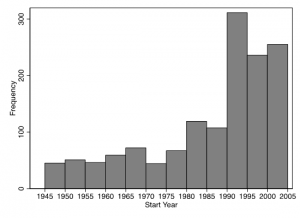Threat and Imposition of Economic Sanctions (TIES) Data
Initiation of Sanctions Cases, 1945-2005 (V.4.0)
We are very pleased to announce the release of TIES Version 4.0. The update extends the previous version of TIES to include all sanctions cases from 1945-2005. The additional data collection from 1945-1970 and from 2001-2005 were merged with the original TIES dataset, which covered sanctions cases from 1971-2000. This version further corrected several identified coding errors from the original version of the dataset. Version 4.0 also adds several new variables to the data, such as dichotomous variable to identify cases with sanctions threats, the start date of sanctions imposition, and the date of the last ongoing news story we could identify about particular cases.
Please use the following citation when using TIES:
Morgan, T. Clifton, Navin Bapat, and Yoshi Kobayashi. 2014. “The Threat and Imposition of Sanctions: Updating the TIES dataset.” Conflict Management and Peace Science 31(5): 541-558.
TIES 4.0
Data: TIES Version 4
Users’ Manual: tiesusersmanualv4
Note: We have identified a few coding errors in the dataset, which are now corrected. A .do file to correct these errors is located here.
Project Description
The conventional wisdom that economic sanctions are not an effective instruments of foreign policy is based on the empirical analysis of numerous cases in which sanctions were applied. This work may suffer from selection bias in that instances in which sanctions would be effective may be characterized by the absence of their imposition. That is, the target may be able to anticipate that it would alter its policies as a result of sanctions and may choose to acquiesce to potential threats in order to avoid the cost of economic dislocation. Using a game theoretic model, this project demonstrates that in equilibrium, any outcome of a sanctions episode is possible with some non-zero probability; but, sanctions that would be effective typically would bring about change in the target’s behavior at the threat stage and would never be applied. The model produces explanations that are consistent with the empirical record and provides explanations for some of the puzzles regarding economic sanctions (such as why they would continue to be imposed despite strong evidence that they are usually ineffective).
The goal of this project is to continue the theoretical development of the model and to develop a dataset with which the hypotheses can be tested. Data on instances in which sanctions were threatened, but not imposed, do not currently exist. Currently, this project has collected data on instances of both the threat and implementation of sanctions during the period from 1971-2000. This dataset is scheduled for release in Spring 2006.
TIES 3.5
This is the original users’ manual for the TIES dataset, version 3.5.
This is the original codebook for the collection of sanctions episodes.
In Data Version 3.5, the individual sanctions episodes are merged into sanctions cases, making all of the variables case level.
google-site-verification: google96a356a3b75674c7.html
